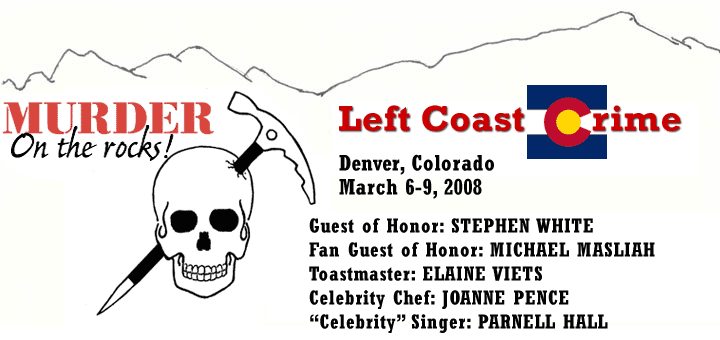
|
||||||||||||||||||||||
|
About Alferd E. Packer In the fall of 1873, a party of men left Salt Lake City heading for the gold fields in the mountains of Colorado. They started out in high spirits, thinking of the riches to come. But they encountered barren wastes and snowy mountains, and were about to turn back in despair when they came upon an Indian camp. The Indians took them to the chief, and they were fed and sheltered until they had recovered from their adventure thus far. Advised by Chief Ouray that the winter would be even worse than what they'd previously encountered and they should turn back, ten of the party members took that very excellent advice. The other ten decided to forge on with their original plan. Chief Ouray gave them provisions and suggested they follow the Gunnison River, which would take them to the Los Pinos Agency. Four of them did, but Packer talked the other six into striking off heading for the headwaters of the Rio Grande, where rich mines were said to have been discovered. In February of 1874, two of the four men who had followed the Gunnison arrived, on the verge of starvation, at the Los Pinos Agency, the other two having perished of exposure and starvation. The group led by Packer was assumed to have been lost. Then, in March of 1874, Packer also appeared at the Agency, described as "wild-looking" and bloated of face but otherwise in good condition. He said his five companions had deserted him when he became ill. However, he was well supplied with money, and bought many rounds of drink, during which his story slipped a bit, to the point where those listening to him began to suspect that he had, in fact, killed his companions and taken their cash. Even worse, the investigation clearly pointed to Packer having murdered and eaten his companions, and he later confessed to it. In fact he confessed to several different versions. In one version one of his companions had shot the others while Packer was gathering firewood, and attempted to kill Packer when he returned to camp—so it was self defense. No one assumed Packer was innocent, particularly when he tried to assault a member of the party he was leading to find the bodies of the men. In June, when thing had thawed somewhat, an artist discovered the remains of Packer's party, which indicated the truth of Packer's confession—at least the part where he said he'd eaten them. He was charged with five murders, but escaped. Nine years later, in March of 1883, authorities caught up with him in Laramie County, Wyoming, where he was said to be involved with a gang of outlaws. He was brought back to Colorado, tried, and found guilty, with the death penalty attached. He immediately appealed and was granted a new trial. This time the verdict was guilty but the sentence was eight years for each offense, for a total of 40 years. He was pardoned in January of 1901, and moved to a ranch in Deer Creek, Colorado (where he was said to have become a vegetarian), and died in 1907. The myth: Convicted of cannibalism The truth: Convicted of murder, reversed on a technicality; reconvicted of manslaughter. The myth: During the trial, the judge supposedly said: "Damn you, Alferd Packer! There were seven Demmycrats in Hinsdale County and you et five of 'em!" The truth: The actual sentencing statement read: "Close your ears to the blandishments of hope. Listen not to the flattering promises of life, but prepare for the dread certainty of death." It should be noted that, as all the men came from Salt Lake City, there was no particular reason for the judge even to have known their political affiliation—if any. For some reason, Packer caught on as a legend in popular culture. His case was written up in Celebrated Criminal Cases of North America, by Thomas S. Duke (1910), and inserted as a direct quote from there into Dashiell Hammett's The Thin Man (1929). Phil Ochs wrote a folk song about him, "The Ballad of Alferd Packer" (1964), with the refrain: "They called him a murderer, a cannibal, a thief; It just doesn't pay to eat anything but Government-inspected beef." In 1968 students at the University of Colorado named the grill in the student union the Alferd G. Packer Memorial Grill, with the motto "Have a friend for lunch!" The cafeteria in the U.S. Department of Agriculture was also briefly named the Alfred Packer Memorial Grill (the plaque proving it resides at the bar of the National Press Club). Packer has also inspired a 1999 movie, Ravenous, and Cannibal: The Musical by Trey Parker (of South Park fame). His legend has also been the subject, over the years, of various mock trials, continuing investigations, CSI-style tests, and a pardon (in 1981). In short, he's the kind of folk villain mystery fans can really sink their teeth into.
MENU: Alferd E. Packer Memorial Banquet Most people only know Alferd E. Packer for the bad things he did in his lifetime...such as eating his enemies. But there's another, gentler side to the man. To show how tasteful Alferd really was, and to help you chose your dinner entrée, we've added explanations that entail a few of Al's favorite tidbits... Alferd's Favorite Song Alferd's Favorite Nursery Rhyme Alferd's Favorite Play If you will be attending the banquet, please send an email with your preference to chris@christinegoff.com.
Logo by Mario Acevedo | |||||||||||||||||||||